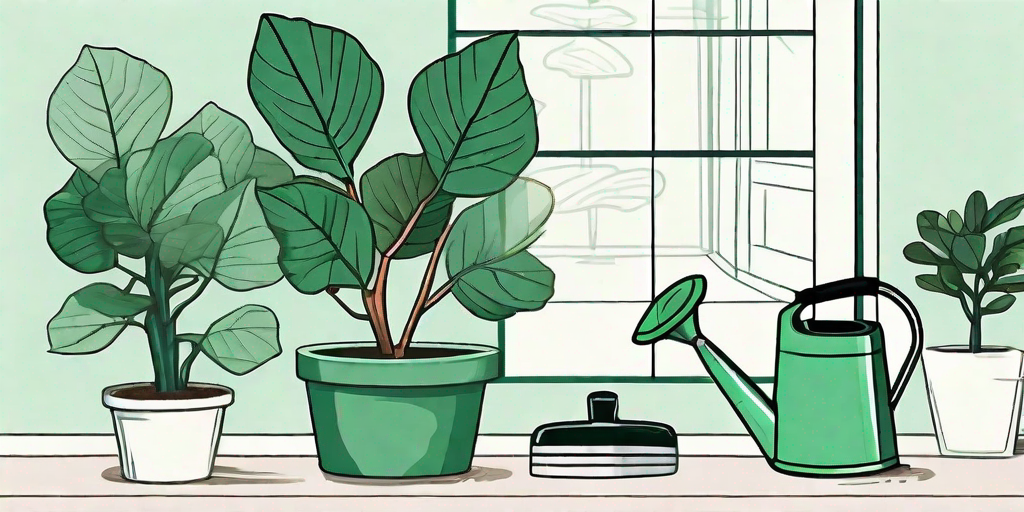
Welcome to the world of Fiddle Leaf Fig (FLF) pruning, where the stakes are high, the rewards are great, and the puns are absolutely terrible. But don't leaf just yet! We promise to stick to the point and branch out only when necessary. So, whether you're a seasoned gardener or a green-thumbed newbie, grab your shears and let's dive into the verdant world of FLF pruning.
Understanding Your Fiddle Leaf Fig
What is a Fiddle Leaf Fig?
Before we start hacking away at your beloved plant, it's important to understand what a Fiddle Leaf Fig is. Native to the tropical rainforests of West Africa, the Ficus Lyrata, or as we like to call it, the Fiddle Leaf Fig, is a popular houseplant known for its large, glossy, violin-shaped leaves. It's a bit of a diva, requiring just the right amount of light, humidity, and water. But with the right care, it can grow up to 50 feet tall. That's right, 50 feet. You might want to rethink that indoor garden...
But don't fret! While they can be a bit finicky, Fiddle Leaf Figs are also incredibly resilient. They can bounce back from almost anything, including your questionable pruning skills. So, let's get to it!
Why Prune a Fiddle Leaf Fig?
Pruning is an essential part of plant care, and your Fiddle Leaf Fig is no exception. Regular pruning encourages new growth, keeps the plant healthy, and helps maintain its shape. Plus, it's a great way to keep your FLF from taking over your living room. Unless, of course, you're into that sort of thing.
Pruning also helps to remove any dead or diseased leaves, ensuring that your plant stays as healthy and happy as possible. And let's be honest, a happy plant makes for a happy plant parent. So, grab those shears and let's get pruning!
How to Prune Your Fiddle Leaf Fig
Tools of the Trade
When it comes to pruning, you'll need a few tools. First and foremost, a pair of sharp, clean pruning shears. Dull or dirty tools can damage your plant and spread disease. And nobody wants that.
Next, you'll need a clean cloth and some rubbing alcohol. Before and after each pruning session, you should clean your shears to prevent the spread of disease. It's like washing your hands, but for your tools.
Finally, you'll need a steady hand and a brave heart. Pruning can be a bit nerve-wracking, especially if you're new to it. But don't worry, we're here to guide you every step of the way.
The Pruning Process
Now that you're armed and ready, it's time to get down to business. Start by examining your Fiddle Leaf Fig. Look for any dead, diseased, or damaged leaves. These are the first to go. Be ruthless, but remember, this is a pruning session, not a massacre.
Next, look for areas where the plant is overcrowded. Removing some leaves will allow light to reach all parts of the plant, promoting healthy growth. It's like giving your plant a little more breathing room.
Finally, don't forget to prune the top of your plant. This will encourage it to grow wider rather than taller, giving it a fuller, bushier appearance. Just be careful not to take off too much. Remember, it's easier to take more off later than to put it back on.
After Pruning Care
Watering and Fertilizing
After a good prune, your Fiddle Leaf Fig will be thirsty. Give it a good drink, but be careful not to overwater. Fiddle Leaf Figs prefer to dry out a bit between waterings. Think of it as a cocktail hour for your plant.
As for fertilizing, your plant will appreciate a good feed after pruning. Use a balanced, water-soluble fertilizer and follow the package instructions. Remember, when it comes to fertilizer, less is more. Over-fertilizing can cause more harm than good.
Light and Temperature
Just like us, Fiddle Leaf Figs love a good dose of sunshine. But they prefer indirect light to direct sunlight. Too much direct sunlight can scorch their leaves, and nobody wants a sunburned plant.
As for temperature, Fiddle Leaf Figs prefer a consistent, warm climate. Keep them away from drafts and sudden temperature changes. They're not fans of surprises.
FAQs
How often should I prune my Fiddle Leaf Fig?
There's no hard and fast rule for this, as it depends on the growth rate of your plant. However, a good rule of thumb is to prune your Fiddle Leaf Fig once or twice a year, usually in the spring and summer when the plant is actively growing.
Can I propagate the cuttings from my Fiddle Leaf Fig?
Absolutely! Fiddle Leaf Fig cuttings can be propagated in water or soil. Just make sure the cutting has a few healthy leaves and a node (the little bump where the leaf meets the stem). With a little patience and care, you'll have a new Fiddle Leaf Fig in no time!
Help! I over-pruned my Fiddle Leaf Fig. What do I do?
Don't panic! Fiddle Leaf Figs are incredibly resilient. Keep caring for your plant as usual and be patient. It may take some time, but your plant will bounce back.
Conclusion
And there you have it, folks! You're now a certified Fiddle Leaf Fig pruning pro. Remember, pruning is more of an art than a science. It takes practice, patience, and a little bit of courage. But with these tips and tricks, you're well on your way to a healthy and happy Fiddle Leaf Fig.
So, go forth and prune! And remember, in the wise words of the great philosopher Monty Python, "It's just a flesh wound."















